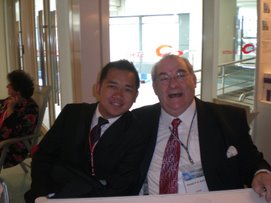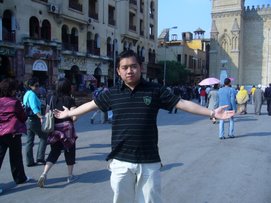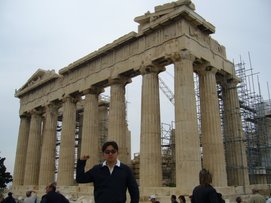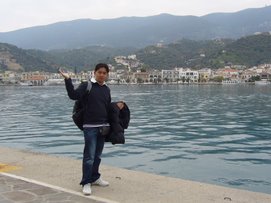 ROME — — Manulife Financial [MFC-T] is among the global insurers poised to launch bids for parts of American International Group [AIG-N], the giant insurer that became a ward of the U.S. government when last week's financial crisis pushed it to the brink of collapse.
ROME — — Manulife Financial [MFC-T] is among the global insurers poised to launch bids for parts of American International Group [AIG-N], the giant insurer that became a ward of the U.S. government when last week's financial crisis pushed it to the brink of collapse. Manulife executives, led by CEO Dominic D'Alessandro, met with financial advisers late last week to consider ways to exploit AIG's probable breakup, sources said.
Buying all of AIG, or big parts of it, would propel Manulife to the top rank of the global financial services industry.
It could also severely damage the company if the hurricanes hitting Wall Street do not lose their fury.
Mr. D'Alessandro isn't talking about Manulife's plans and did not return e-mails seeking comment. Manulife spokeswoman Laurie Lupton declined to comment yesterday.
AIG, the world's biggest insurer, would have collapsed had the U.S. Federal Reserve not agreed to lend it up to $85-billion (U.S.) in exchange for 79.9 per cent of its equity, making its rescue a de facto nationalization. Analysts expect AIG to be sold, in whole or in part.
While other insurers, ranging from Germany's Munich Re to Australia's QBE Insurance, are also potential bidders for large chunks of AIG, Manulife is viewed by some as a more logical suitor.
The Toronto-based insurer is a strong player in a weak market.
Like other insurers and banks that escaped the worst of the credit crunch, the company is ready to feast on the remains of the companies consumed by their own excesses, analysts said.
In a note published last Wednesday, Citigroup insurance industry analyst Colin Devine called Manulife, Canada's largest insurer, "an ideal candidate to make an aggressive bid for AIG."
"We consider [Manulife] the only insurer in the world with sufficient balance sheet strength that would allow it to bid for all of AIG's U.S. and Asian life insurance businesses," Mr. Devine said in his report.
Manulife's share price - $35.15 on Friday - is only 24 per cent off its 52-week high, giving it a market value of $52-billion.
Its profits, balance sheet and investment portfolio are robust and its insurance subsidiaries are rated triple-A, Standard & Poor's top rating. It has $3-billion in excess capital and could borrow much more to finance a deal.
Mr. D'Alessandro, 62, is set to step down as CEO by next spring, and he is to be replaced by chief investment officer Don Guloien. With little more than half a year to go, Mr. D'Alessandro might be reluctant to plunge himself and his executives into yet another transformational deal. Nor could he do it without Mr. Guloien's approval. Whatever Mr. D'Alessandro starts, his successor will have to finish.
But Mr. D'Alessandro has always wanted to build a Canadian-based global champion, and prizes like AIG come along only once in a century.
AIG's share have gone from a high of $70.11 to about $4, giving the biggest name in the business a market value of a mere $10-billion. The insurer's Asian business would turn Manulife into a powerhouse in that part of the world. Manulife is already third among foreign insurers, measured by earnings contribution from Asia. AIG is first, with 70 per cent of its earnings from Asia.
Analysts say AIG's crown jewels are its Asian operations and the group pension business in the United States. The U.S. business would be doubly attractive to Manulife because of the synergy potential with John Hancock, the big U.S. insurer bought by Manulife in 2004 for about $11-billion.
AIG is certainly a target. Its loan from the Fed comes at a punitive interest rate - 8.5 percentage points above the London interbank offered rate (Libor). The expensive loan gives AIG a huge incentive to unload assets so it can pay back the money quickly. Even before last week's nightmare, AIG had announced its intention to sell International Lease Finance Corp., the largest aircraft leasing business.
Manulife could make a quick offer for the whole company, which would please the regulators.
The problem is that the toxin levels in AIG's portfolios are not known. Buying certain divisions would be far less risky for Manulife or any other bidder.
The risk that comes with buying divisions instead of the whole company is getting trapped in bidding wars with powerful foreign rivals eager to build their U.S. presence.
Buying parts of AIG would be very much in character for Mr. D'Alessandro, who turned Manulife into a perpetual motion machine. Under him, the company de-mutualized and joined the stock market in 1999. He was keen to have a takeover to build the company.
In 2002, he bought Zurich Life's Canadian arm and tried to buy CIBC, an effort that was stopped by John Manley, the finance minister at the time. A year later, he landed John Hancock. Businesses were collected across Asia.
Today, Manulife is the top insurer in Canada, the second-biggest in North America and the sixth-biggest in the world. Half of its earnings come from the United States, with the other half split between Asia and Canada.
Size doesn't guarantee success, as AIG found. But Manulife is no AIG. While it has been an aggressive purchaser of companies, it was careful not to pay too much. In 2003, for instance, it ended its pursuit of Canada Life when the bidding got too rich (Great-West Lifeco was the winner).
Crucially, it shied away from products that seemed too good to be true, like credit default swaps, or CDSs, which are insurance against defaults on assets linked to corporate debt and mortgage securities. AIG teetered when it was downgraded by S&P on Sept. 15 and was suddenly unable to come up with the collateral to back its swaps. That's when the Fed came charging to the rescue. Its collapse would have sent financial shockwaves around the planet.











1 comment:
sure, will check it out now run with the wave, nice to meet you, adios..
Post a Comment